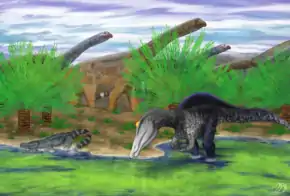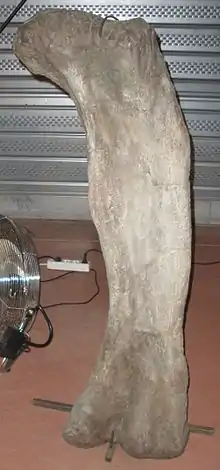Phuwiangosaurus
Phuwiangosaurus (meaning "Phu Wiang lizard") is a genus of titanosauriform dinosaur from the Early Cretaceous (Valanginian-Hauterivian) Sao Khua Formation of Thailand. The type species, P. sirindhornae, was described by Martin, Buffetaut, and Suteethorn in a 1993 press release[1] and was formally named in 1994.[2][3] The species was named to honor Princess Maha Chakri Sirindhorn of Thailand, who was interested in the geology and palaeontology of Thailand, while the genus was named after the Phu Wiang area, where the fossil was discovered.

| Phuwiangosaurus | |
|---|---|
 | |
| Femur | |
| Scientific classification | |
| Kingdom: | Animalia |
| Phylum: | Chordata |
| Clade: | Dinosauria |
| Clade: | Saurischia |
| Suborder: | †Sauropodomorpha |
| Clade: | †Sauropoda |
| Clade: | †Eusauropoda |
| Clade: | †Neosauropoda |
| Clade: | †Macronaria |
| Family: | †Euhelopodidae |
| Genus: | †Phuwiangosaurus Martin, Buffetaut and Suteethorn, 1994 |
| Type species | |
| †Phuwiangosaurus sirindhornae Martin, Buffetaut and Suteethorn, 1994 | |
In 2010 Paul gave a length of 19 meters (62 ft) and a weight of 17 tonnes (18.7 short tons).[4] In 2012 Holtz gave a higher estimation of 25 meters (82 ft).[5]
Phuwiangosaurus was originally assigned to Titanosauria, but more recent studies have placed it in a more basal position within the Titanosauriformes. Phylogenetic analyses presented by D'Emic (2012), Mannion et al. (2013), and Mocho et al. (2014) resolve Phuwiangosaurus within the Euhelopodidae, alongside genera such as Euhelopus and Tangvayosaurus.[6][7][8] Other analyses have failed to find support for such a grouping,[9] including some finding it to be paraphyletic at the base of Somphospondyli.[7][10]
References
- Martin, V.; E. Buffeataut; V. Suteethorn (1993). "Jurassic sauropod dinosaurs of Thailand: a preliminary report". In T. Thanasutipital (ed.). Proceedings of the International Symposium on Biostratigraphy of mainland Southeast Asia. Chiang Mai University. pp. 415–425.
- Martin, V.; E. Buffeataut; V. Suteethorn (1994). "A new genus of sauropod dinosaur from the Sao Khua formation (Late Jurassic or early Cretaceous) of northeastern Thailand". Comptes rendus de l'Académie des Sciences de Paris. 319 (2): 1085–1092.
- Martin, V.; E. Buffeataut; V. Suteethorn (1999). "Description of the type and referred material of Phuwiangosaurus sirindhornae Martin, Buffetaut and Suteethorn, 1994, a sauropod from the Lower Cretaceous of Thailand". Oryctos. 2: 39–91.
- Paul, Gregory S. (2010). The Princeton Field Guide to Dinosaurs. New Jersey: Princeton University Press. pp. 205.
- Holtz, Thomas R. (2012). "Holtz's Genus List" (PDF).
- D'Emic, M. D. (2012). "The early evolution of titanosauriform sauropod dinosaurs". Zoological Journal of the Linnean Society. 166 (3): 624–671. doi:10.1111/j.1096-3642.2012.00853.x.
- Mannion, P. D.; Upchurch, P.; Barnes, R. N.; Mateus, O. (2013). "Osteology of the Late Jurassic Portuguese sauropod dinosaur Lusotitan atalaiensis (Macronaria) and the evolutionary history of basal titanosauriforms". Zoological Journal of the Linnean Society. 168: 98–206. doi:10.1111/zoj.12029.
- Mocho, P.; Royo-Torres, R.; Ortega, F. (2014). "Phylogenetic reassessment of Lourinhasaurus alenquerensis, a basal Macronaria (Sauropoda) from the Upper Jurassic of Portugal". Zoological Journal of the Linnean Society. 170 (4): 875–916. doi:10.1111/zoj.12113.
- D'Emic, M. D. (2013). "Revision of the sauropod dinosaurs of the Lower Cretaceous Trinity Group, southern USA, with the description of a new genus". Journal of Systematic Palaeontology. 11 (6): 707–726. doi:10.1080/14772019.2012.667446.
- Zaher, H.; Pol, D.; Carvalho, A.B.; Nascimento, P.M.; Riccomini, C.; Larson, P.; Juarez-Valieri, R.; Pires-Domingues, R.; da Silva Jr, N.J.; de Almeida Campos, D. (2011). "A complete skull of Early Cretaceous sauropod and the evolution of advanced titanosaurians". PLOS One. 6 (2): e16663. Bibcode:2011PLoSO...616663Z. doi:10.1371/journal.pone.0016663. PMC 3034730. PMID 21326881.












